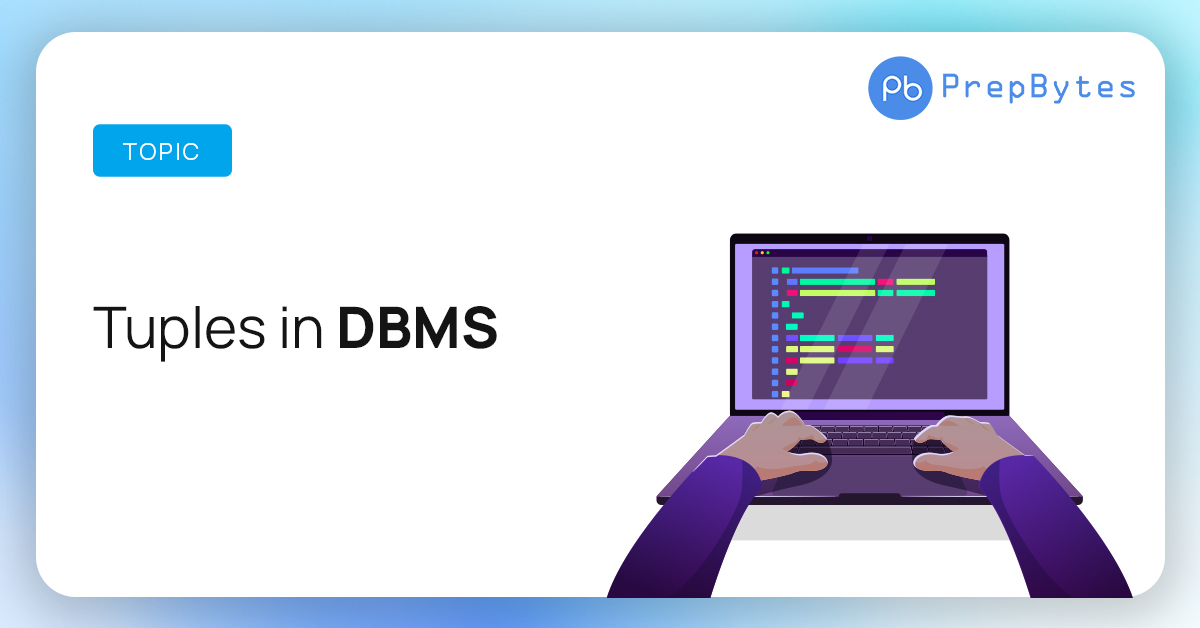Last Updated on April 27, 2023 by Prepbytes

Tuples in DBMS have been a fundamental concept since the early days of relational database theory, which originated in the 1960s. A tuple is a row in a table that contains data in the form of attributes or fields. Each tuple is uniquely identified by a primary key, which is a column or combination of columns that have unique values for each row in the table.
What is DBMS?
A database management system (DBMS) is a software application that enables users to create, manage, and manipulate data in a structured way. It provides an interface to interact with a database, which is a collection of related data stored in an organized manner. DBMS ensures data integrity, security, and availability while allowing efficient access and retrieval of data. It also supports various data models such as relational, hierarchical, network, and object-oriented. Whether relational or not, a database represents logically related data put together. So, we might also need to add or remove some data from the database. So, we will need some instructions to add or remove data from the database.
When we combine the database and instructions required to handle this database together, we gate a Database Management System (DBMS). So, a DBMS is a combination of a database and programs required to handle (modify i.e. read, add or remove data) this database.
Some examples of popular databases are SQL, MongoDB, etc.
So, now that we have understood what a database is, let us understand the meaning of tuples in DBMS.
Define Tuple in DBMS
A tuple in DBMS that represents a single record or row in a table. It contains a set of attributes or fields that define the properties of an entity being represented, such as a person, product, or event. Tuples play a crucial role in the functioning of a relational database, as they enable efficient storage, retrieval, and manipulation of data. By grouping related attributes into a single tuple, DBMS can ensure data consistency and integrity while allowing fast access to information.
Tuple Example
Let us see the tuple in DBMS with the example:
| Student ID | Student Name | Marks (in %) |
|---|---|---|
| 1 | Guneet | 90 |
| 2 | Yash | 87 |
| 3 | Ashish | 90 |
| 4 | Karan | 78 |
| 5 | Akhilesh | 93 |
Explanation of tuple in DBMS:
The above table is a Tuple example of the tuple in DBMS that lists the details of five students, along with their respective marks in percentage. The first column represents the Student ID, a unique identifier assigned to each student in the database. The second column lists the name of the student. The third column shows the marks obtained by each student in percentage.
Student ID 1, named Guneet, has scored 90% marks. Similarly, the table lists the details of four other students, including Yash, Ashish, Karan, and Akhilesh, along with their respective marks. This table could be used for a variety of purposes, such as tracking the academic performance of students, generating reports, or identifying students who need extra support or intervention. The data in this table could be queried, filtered, sorted, and aggregated using SQL or other database tools to extract useful insights and information.
Conclusion
In conclusion, tuples are an important concept in database management systems and the relational model, as they provide a way to organize and query data in a structured and efficient manner. They are widely used in relational databases and are a key concept for anyone working with data in a database context.
Frequently Asked Questions(FAQs)
Q1. What is the difference between a tuple and a record in DBMS?
Ans: In DBMS, the terms tuple and record are often used interchangeably to refer to a single row of data in a table. However, some people use "tuple" to refer specifically to a row in a relational database, while "record" may be used more broadly to refer to a row in any type of database.
Q2. Can tuples have duplicate values in DBMS?
Ans: Yes, tuples can have duplicate values in DBMS. However, in a relational database, each tuple is uniquely identified by a primary key, which ensures that no two tuples in the same table have the same combination of values.
Q3. How are tuples related to SQL in DBMS?
Ans: SQL (Structured Query Language) is a programming language used to manage relational databases. Tuples are a core concept in SQL, as they represent the rows of data in a relational table. SQL statements like SELECT, INSERT, UPDATE, and DELETE are used to manipulate tuples in a database.
Q4. What is the significance of tuples in DBMS?
Ans: Tuples are significant in DBMS because they provide a standardized and efficient way to represent and manipulate data in a relational database table. By grouping related attributes or fields into a single tuple, DBMS can ensure data consistency and integrity while enabling fast access and retrieval of information.


